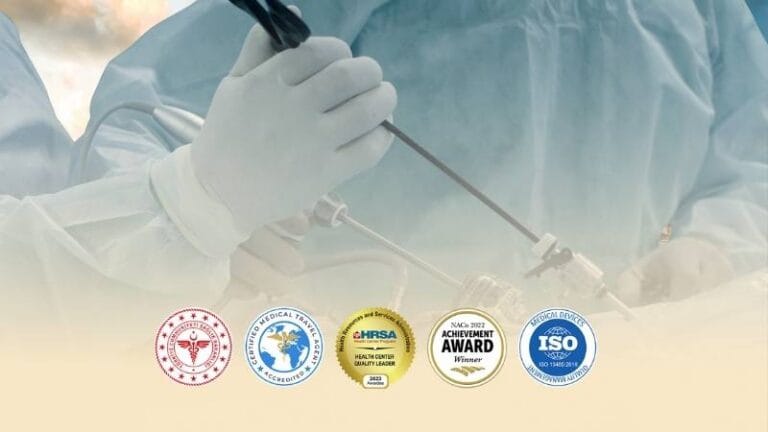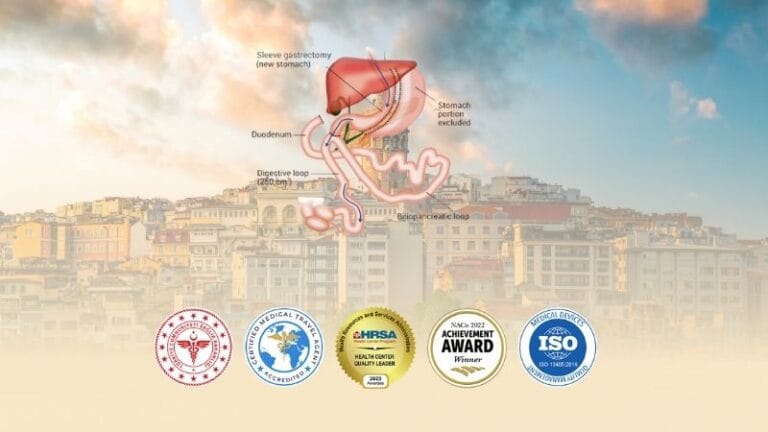The average Mini Gastric Bypass in Turkey Cost 2026 offers a highly effective metabolic solution for patients battling obesity and Type 2 Diabetes who require a procedure more powerful than a Sleeve but less complex than a traditional Bypass. Also medically known as the One Anastomosis Gastric Bypass (OAGB), this surgery is a cornerstone of modern bariatric care, delivering profound weight loss results through a simplified surgical technique.
Why is it Called “Mini”? (Anatomy Explained)
The term “Mini” is often misunderstood; it refers strictly to the shorter operating time and simplified technique, not the results. In a traditional RNY Gastric Bypass, the surgeon must make two separate connections (anastomoses) to reroute the intestine. In a Mini Gastric Bypass, the surgeon creates a long, tube-like stomach pouch and connects it to a loop of small intestine roughly 150-200cm down.
This single connection (one loop) significantly reduces the time under anesthesia (often 45-60 minutes) and lowers the technical risk of leakage. Despite being faster to perform, it bypasses a longer section of the intestine than the standard bypass, often resulting in superior weight loss and diabetes resolution for patients with a BMI over 45.
Clinic Care Center: Expert Warning (Bile Reflux Risk)
While Mini Gastric Bypass is excellent for weight loss and diabetes control, it has one specific weakness: Bile Reflux. Because there is no valve between the small intestine and the new stomach pouch, bile can sometimes wash back up into the stomach. If you already suffer from severe Acid Reflux (GERD), MGB is NOT recommended for you. In such cases, the traditional RNY Gastric Bypass is the gold standard. We perform strict pre-op endoscopy to ensure you are the right candidate.
Mini Gastric Bypass Cost 2026 vs. RNY & Sleeve
| Procedure | Turkey Price (All-Inclusive) | Op Time | Reflux Risk |
|---|---|---|---|
| Mini Gastric Bypass (MGB/OAGB) | $3,200 – $4,500 | 45 – 60 Mins | Moderate (Bile Reflux) |
| RNY Gastric Bypass (Standard) | $3,800 – $5,000 | 90 – 120 Mins | Low (Cures Reflux) |
| Gastric Sleeve (VSG) | $2,500 – $3,500 | 45 – 60 Mins | High (Acid Reflux) |
| Revision (Sleeve to MGB) | $4,000 – $5,500 | 90 Mins | Moderate |
Vitamin Needs & Package Inclusions
Our all-inclusive packages are designed to support your metabolic reset. Standard inclusions involve:
- Pre-operative Endoscopy and Cardiology clearance.
- 3 Nights Hospital Stay with bariatric nursing care.
- Surgeon and Anesthesiologist fees.
- VIP Transfers and Hotel Accommodation for your companion.
However, patient compliance is critical for long-term health. Because MGB bypasses a long section of the intestine, it is more ‘malabsorptive’ than the Sleeve. You will need to take Iron, Calcium, and B12 supplements for life. Your package includes 1 year of dietitian follow-up to prevent anemia and ensure your nutrition remains balanced.
Frequently Asked Questions (FAQ)
Is Mini Gastric Bypass reversible?
Yes. One of the major advantages of the MGB/OAGB over the Sleeve Gastrectomy (where the stomach is removed) is that it is technically reversible. The loop can be undone, and the normal anatomy restored, although this is rare and only done in cases of severe malnutrition.
Will I lose more weight than with a Sleeve?
Statistically, yes. Studies show that MGB patients typically lose 75-85% of their excess weight, whereas Sleeve patients lose around 60-70%. The added malabsorption component of the bypass drives this superior result.
What happens if I get Bile Reflux?
If you develop severe, unmanageable bile reflux after surgery (occurring in about 1-2% of patients), the procedure can be converted into a traditional RNY Gastric Bypass. This diverts the bile away from the stomach, instantly curing the reflux.
Can I get pregnant after MGB?
You must wait at least 18 months after surgery before attempting pregnancy. Rapid weight loss releases hormones that can harm a developing fetus, and nutritional stability is crucial. Once your weight stabilizes, pregnancy is safe with proper monitoring.
How big is the stomach pouch?
The MGB pouch is long and narrow, shaped like a tube (similar to a Sleeve but without removing the rest of the stomach). It holds significantly less food than a normal stomach, providing strong restriction and satiety.
Is it safe for super-obese patients?
Yes, it is often the preferred operation for patients with a BMI > 50 (“Super Obese”). Because it is faster to perform than a standard bypass, the time under anesthesia is reduced, lowering the risk of respiratory or cardiac complications during surgery.
Powerful Weight Loss, Simplified Surgery
Don’t let the name ‘Mini’ fool you. This is a robust solution for diabetes and obesity. To determine if your anatomy is suitable for OAGB or if you need a standard Bypass, contact Clinic Care Center today for a medical consultation and 2026 cost breakdown.


